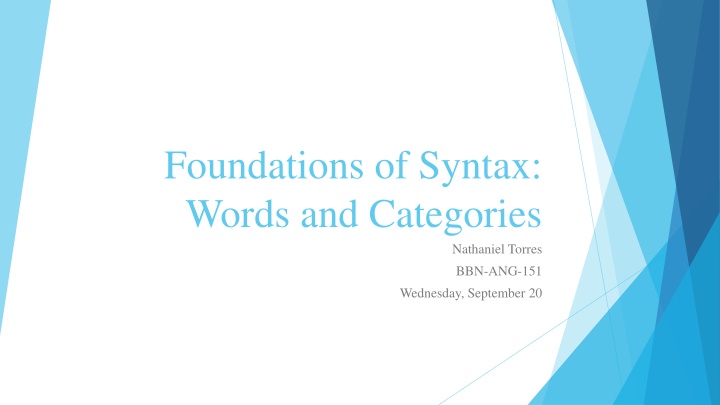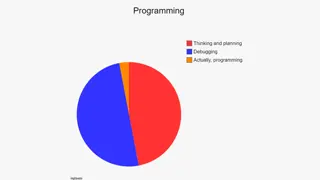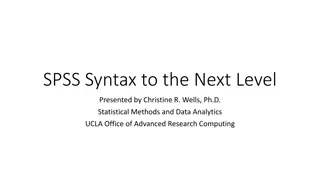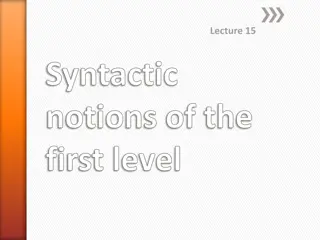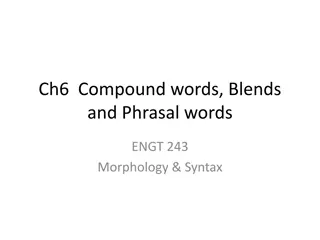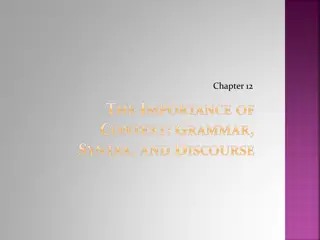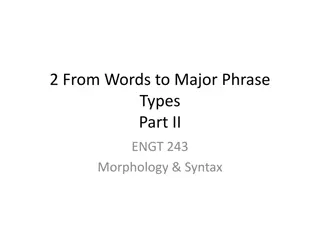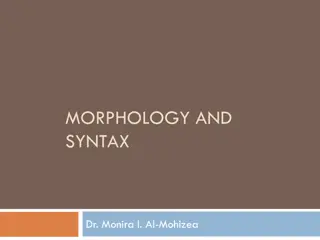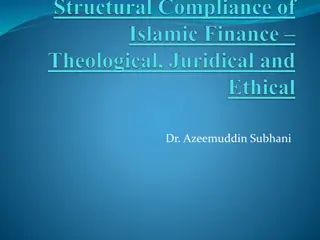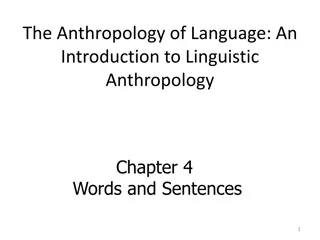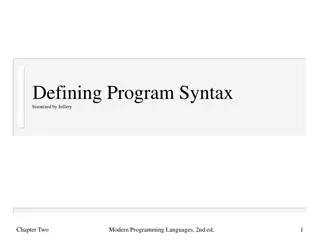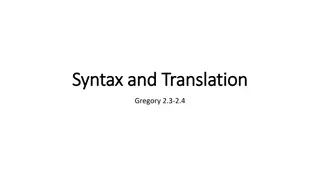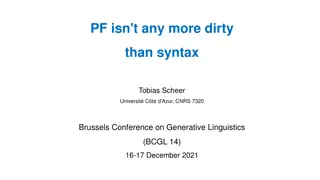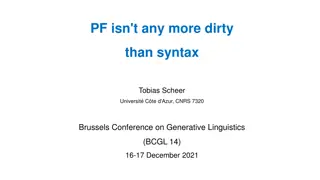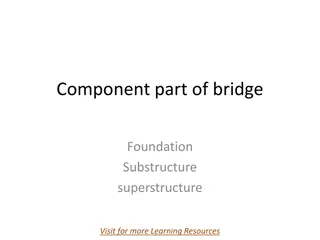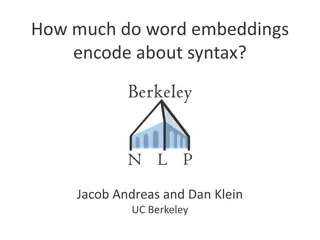Foundations of Syntax: Words and Categories Overview
In the study of language, lexicon plays a crucial role as a mental inventory of words with specific meanings. This article delves into word categories such as nouns, adjectives, verbs, and prepositions, exploring syntactic relations and grammaticality through examples.
Download Presentation

Please find below an Image/Link to download the presentation.
The content on the website is provided AS IS for your information and personal use only. It may not be sold, licensed, or shared on other websites without obtaining consent from the author.If you encounter any issues during the download, it is possible that the publisher has removed the file from their server.
You are allowed to download the files provided on this website for personal or commercial use, subject to the condition that they are used lawfully. All files are the property of their respective owners.
The content on the website is provided AS IS for your information and personal use only. It may not be sold, licensed, or shared on other websites without obtaining consent from the author.
E N D
Presentation Transcript
Foundations of Syntax: Words and Categories Nathaniel Torres BBN-ANG-151 Wednesday, September 20
Basic Overview Knowledge about a language is specific to the language in question. A speaker of any language has a mental inventory of words with allotted sounds to pronounce them and specific meanings tied to them. This reservoir of words is called the Lexicon.
The Lexicon In English, we have the word dog, which in the lexicon of native English speakers refers to a 4-legged canid. Other languages do not represent or pronounce this idea with the same word, cf.: Hungarian: kutya Spanish: perro Galician: can Russian: sobaka ( ) Japanese: inu ( )
Lexicon (cont.) The items that compose our lexical inventories are very specific in their use, that is, they typically cannot occur just anywhere. Consider: *The cat dog the man. *Dog eat the bone. *The cat sleeps the dog. We can, however, say: The man fed the dog.
Lexicon (cont.) Consider the following grammatical examples: The dog chewed on the bone. Peter fed the dog. Sadie went to the park with her dog. We can see that the position of dog in relation to the words around it now affects the grammaticality of the sentence. Is this always the case?
Grammaticality? Consider the following examples: Furious green dreams sleep furiously. I tripped over the freedom. Sally watered my liberty. All of these sentences are syntactically grammatical, but they are semantically nonsensical. Languages therefore construct sentences that rely on not just words, but also their meanings and their ability to complement the meanings of other words through various semantic and syntactic relations.
Word Categories We can now categorize the words in our lexicon as the following: Noun Adjective Verb Preposition
Word Categories (cont.) We must now determine how we can identify each of the word categories and distinguish them from each other. There are a number of diagnostics that allow us to be able to determine the category of a word. Let s look at one. Morphology. Consider the plural morpheme s: cat cats dog dogs *happily happilies *warm - warms
Categories (cont.) The plural morpheme s can only be affixed to words of the category noun. (Not to be confused with the 3SG verb agreement marker s.) Word categories allow us to define the number of possible positions words of a particular category can occupy in a sentence. Languages will differ on this point, so we ll look at just English for now. Let s consider English permits only words of the category noun to precede a verb. This allows us sentences like: The cat ate the food. But not: *Ate the food. The set of possible positions that a particular word category can take is known as its distribution.
Distribution We must carefully consider the idea of distribution because the sentence we have considered would seem to indicate that the categorical distribution of words in English is noun-verb-noun. This is not the case: *John grins the sky. This would force us to posit that certain words require certain constructions and word orders. We can now posit that words subcategorize for other word categories which will lead to constructions that are in complementary distribution.
Subcategorization Subcategorization refers to a process by which a given category can select for another kind of word category. Let s start with verbs. Consider the verb hit. When taking words into account, we have to think about how they are used. So, the first question is, can we say: I hit. No. Can we say the following: I hit the ball. Yes. This means that the verb hit subcategorizes for a noun object: Hit <noun> Verbs like hit form a class of verb called transitive verbs.
Subcategorization (cont.) How about verbs like fall, arise, come, go? These do not necessarily select for particular words in order to complete their meanings in the same way that hit does. Consider: I m falling. BUT *I m falling a dog. I m going. BUT *I m going market. (Although cross-linguistically, go can be transitive indicating the goal of movement.) I m coming. BUT *I m coming the cat. I have arisen. BUT *I have arisen the mummy. This means that these verbs form a fundamentally different class of verbs from the ones like hit. These are intransitive verbs, and these do not subcategorize for a noun direct object.
Subcategorization (cont.) Verbs are not the only words that subcategorize. Of the other thematic categories, all the others also subcategorize. Consider English prepositions: in, on, at, with, by, etc. Compare the following: *John is at. BUT John is at the store. *Mary is eating in. BUT Mary is eating in the restaurant. *Kate is in the park with. BUT Kate is in the park with Steve. The case of English prepositions therefore requires an analysis in which the preposition subcategorizes for a noun in order to complete its meaning. If not, the structure collapses and the sentence we get are ungrammatical as a result. So, PREP <noun>.
Nouns and Adjectives Do nouns and adjectives also require a subcategorization feature? Consider: John is happy. John is happy about his grade. Mary saw the picture. Mary saw the picture of the puppies. Kate is proud. Kate is proud of her son. I abhor the assumption. I abhor the assumption that I ate the last piece of cake.
Nouns and Adjectives (cont.) In all of the examples on the previous slide, we can clearly see that the sentences are grammatical. We also notice that the adjectives and the nouns can come with optional information that is not needed. This information comes in the form of prepositional phrases, or as in the last case, an embedded clause. Because this information is considered optional, and the nouns and adjectives can occur on their own, we can say that they do not subcategorize for anything. This means that they can stand on their own without the aid of another category to help complete their meanings lexically.
Summary Of the thematic categories, we can say the following: Certain verbs and all prepositions require subcategorization in order to complete their lexical meanings and be properly saturated syntactically. Nouns and adjectives do not require any form of subcategorization to complete their meanings and can therefore appear in a clause on their own.
Typology The lexicon splits word categories into two major groups: thematic and functional. Let s start with thematic categories. These include the ones we have already mentioned, i.e., noun, adjective, verb, and preposition. One way we can define each of these categories is through something called features. Features are a set of properties that are inherent to a specific word, or in this case, category.
Typology (cont.) Features are given with brackets and a value + or -. For the category of thematic words, we can postulate that they lack a feature that would otherwise define them as functional, that is, [-F]. By extension, we can also posit a feature [+N] (for nouns) or [+V] for verbs.
Exercise Features can be combined to create feature inventories for categories, for example, X = [+ , - , + ]. Come up with the feature inventories for nouns and verbs based on that model.
Typology (cont.) How about adjectives and prepositions? Consider the following: John is tall/sweating. The tall/sweating man. In both sentences, the distribution of adjectives seems to overlap with the distribution of both nouns and verbs, which means that adjectives must have the following features: Adj = [-F, +N, +V]. By extension, we can now posit the features for the remaining category, prepositions. Prepositions do not share any properties with any of the other categories and as such we can effectively posit the following features: Prep = [-F, -N, -V].
Exercise Consider the following words from Finnish: kissa cat talot houses hyv good kissat cats sanoa to say sanot you say talo house hyv ksyt you accept hyv ksy to accept punainen red sininen blue v synyt tired For each of the words, categorize them into the relevant thematic categories. Justify your categorizations based on morphemic evidence and meaning.
